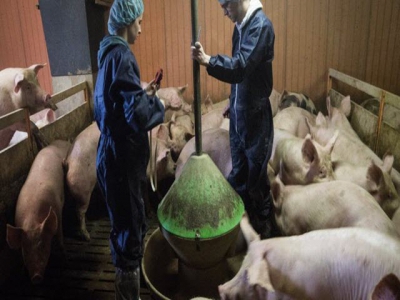Investing in biosecurity called key step to curb spread of animal diseases

While most European countries have legislation and action plans for animal biosecurity, only half have national funds to support biosecurity.
Animal diseases, such as avian influenza or African swine fever, know no borders and can continually affect new areas. Reducing the risk is possible through the implementation of procedures designed to avoid the introduction and spread of pathogens in animal populations, according to an announcement from the World Organization for Animal Health (OIE).
Veterinary services, in collaboration with the numerous stakeholders working with animals, have a key role in ensuring that appropriate biosecurity measures are in place, OIE said, noting that a recent survey conducted among OIE members of the Europe region shows the current challenges faced in this regard.
Animal diseases are among the most significant limiting factors for livestock production, and their impact can vary from reduced productivity and restricted market access to the elimination of entire flocks or herds, triggering heavy economic consequences. In some cases, they can also threaten human health, OIE said.
The appropriate implementation of biosecurity principles can prevent the transmission of pathogens to animals, humans and the environment as detailed in the OIE Standards and guidelines. Measures, such as good farming practices and control of animal and product movements, for instance, are crucial to prevent and contain outbreaks.
At the 28th Conference of the OIE Regional Commission for Europe, held Sept. 17-21 in Tbilisi, Georgia, the results of a survey on the application of biosecurity in different production systems at individual, country and regional levels were presented.
The findings show that the vast majority of responding countries have appropriate national legislation (94.87%) and enforced action plans (92.31%) with regard to biosecurity, OIE said. However, only half of the respondents indicated that their country had national funds to support the implementation of biosecurity measures or good farming practices (53.85%).
Furthermore, although implementation of biosecurity plans occurs most frequently in commercial poultry and pig production systems in Europe, the survey highlighted the need to enhance biosecurity in backyard and non-commercial farms, which can play a role in the spread of diseases, OIE emphasized.
Considering current animal health challenges, all countries need to be vigilant. This was illustrated by the recent cases of African swine fever reported in several European countries. Cases have also recently been reported in China with devastating consequences, OIE said. The scenario is challenging, and in the absence of an effective vaccine, implementing OIE-recommended biosecurity measures on farms and at all country entry points is essential, in addition to other measures such as disease surveillance and early detection.
OIE said implementing biosecurity requirements involves not only veterinarians but also numerous stakeholders such as hunters, farmers and transporters.
Avian influenza is another concern that should be considered as the winter season approaches in the Northern Hemisphere, which is usually associated with an increased risk of influenza. Wild birds play a role as reservoirs and vectors of the virus, but other factors of transmission could be important unless appropriate biosecurity measures are set in place, OIE said.
OIE added that the capacity of countries to implement biosecurity measures in their territory is crucial. Investing in appropriate training and awareness raising of all stakeholders involved is a key responsibility of national authorities to change behaviors and improve the effectiveness of disease control programs.
Related news
 Fruits and veggies join Vietnam's export staples
Fruits and veggies join Vietnam's export staples With a growth rate of 14% year-on-year, it is estimated that exports of vegetables and fruits could reach US$4 billion by the end of 2018, Tien Phong newspaper
 Get to know how your crop ‘thinks’
Get to know how your crop ‘thinks’ A crop has no way of ‘knowing’ or ‘sensing’ your good intentions. Instead, it responds to the prevailing conditions as a means of self-preservation.
 Lam Dong leads in attracting FDI in hi-tech agriculture
Lam Dong leads in attracting FDI in hi-tech agriculture Located in the Central Highlands, Lam Dong province is blessed with a mild climate and fertile soil suitable for agriculture.